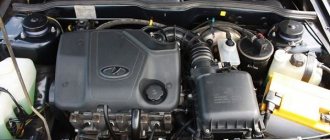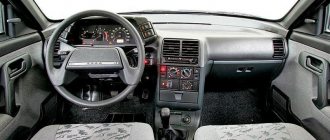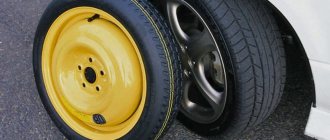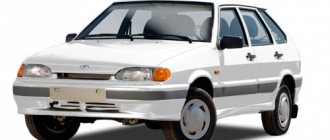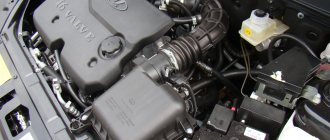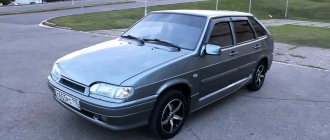We learned that a real limousine can be made from an ordinary pre-wheel drive Lada back in 1994, when at one of the Auto Shows a version of the VAZ 21099, Amadeo 500, extended by half a meter, from the Togliatti company Master Design, was shown.
Photo stolen from the Internet
The idea was bold to the point of absurdity, but... “Ninety-nine” was, to put it mildly, of little use as a base for stretch. However, with the appearance of Amadeo, something clicked in the public consciousness, stereotypes wavered and collapsed. It became possible to think about a limousine based on Lada. All that remained was to wait for a more suitable base model. Which naturally became the “Ten”, VAZ 2110.
The Ten, stretched by 175 mm, called VAZ 21108, is where the history of the Tolyatti company Super-Auto began. It began on January 24, 1997, although no one will remember what exactly happened that day. Then, at the beginning of 1997, VAZ vice-president for technical development (and, concurrently, Kadannikov’s friend) Konstantin Sakharov agreed with the management of AvtoVAZ maintenance to rent one of the buildings of the Togliatti-VAZ Auto Center. They decided to call the company, not without pretension, Super-Auto, because they wanted to make the most prestigious and expensive modifications of the “Ten”. On the list of Super-Auto founders you can find the former director of the OPP Sergei Perevezentsev, the chief VAZ technologist Vladimir Peresypkinsky, the head of VAZ social security Alexander Pushkar and the future chief designer of VAZ Vladimir Guba. The name of the last Super-Auto is still associated...
The company’s website says that the first car was not a limousine, but an ordinary “Ten”, only with an Opel 150-horsepower engine (VAZ 21106). There is information that they also made several samples of a pickup truck from the long-wheelbase Niva. However, this is not confirmed by other sources: 21106 and VAZ 2129 Pickup were produced in those years by the Togliatti company Motorika.
It is known for certain that in 1998 the VAZ 21108 “Premier” appeared - the same stretch on the 2110 platform. It also had a simple 8-valve engine.
I note that the official history of Super-Auto, posted on the company’s website, is replete with ambiguous passages: “a specialized structural entity operating under the auspices of AvtoVAZ OJSC,” “a specialized partner of AvtoVAZ OJSC...” With this, of course, the founders of the company emphasize the proximity to the “parent” enterprise . Legally, Super-Auto did not have and does not have any relation to VAZ; it is a completely independent enterprise, neither a subsidiary nor a structural unit (which, for example, Bronto and OPP were). Although Super-Auto’s informal ties with VAZ are stronger than those of other “subsidiaries”...
In 2004, the 21128 engine with a volume of 1.8 and a power of 105-107 hp was developed for the VAZ 21108. Of course, on the basis of the VAZ, having wasted it. This engine was assembled at the VAZ OPP. As the director of Super-Auto Alexey Rodionov said (he was the one who was involved in the preparation of production ten years ago), the engine turned out to be good, but... unstable. There were problems with the honing of the blocks (this was done by a contractor) and with the quality of the ShPG. As a result, each engine is a lottery; one could go 300,000 km without major repairs, the other barely reached 30,000 km.
Alexey Rodionov, General Director of Super-auto. Started working for the company in 2001 as a support engineer
At first, there weren’t many long “Ten” cars made, a few dozen cars a month. But even this volume was profitable due to the high added value. The VAZ 21108 turned out to be in demand among the VAZ management, who were not supposed to drive foreign cars on official business. But I no longer wanted to drive standard VAZs. With the help of Bronto, they even made two armored vehicles with Opel engines for Vitaly Vilchik, the then director of VAZ. These cars, having changed several owners, are still alive and are now in private hands. True, the armor was removed from them long ago. By 2000, production of 108s jumped to 500 units and became very good; other models were forgotten for some time in the wake of success.
But Super-Auto has never produced real limousines with an interior partition. Although such cars existed in nature, they were single products of other Tolyatti companies, for example, Spetsavto. Super-Auto also had a joint project with Spetsavto – a coupe based on the “Ten” (LADA 21128 Coupe Sport). Unfortunately, not many of these machines were produced at both sites, although the machine turned out to be spectacular.
Photo of the Dozens coupe still hangs in the office of the director of Super-Auto
The designers of Super-Auto then made the front suspension on a subframe, widened the track, boosted the engine to 125 hp... But they managed to assemble only five or six cars - the demand for such an exclusive was low. It's time to refocus on something more widespread.
And such a product turned out to be cars of the “tenth” family with the 21128 engine. For a long time they became the hallmark of the company. And when the Priora appeared, a 105-horsepower engine was adapted for it, this car bore the index 21703.
In the mid-2000s, Super-Auto won a number of tenders and supplied cars to government agencies, primarily the Ministry of Internal Affairs and the Federal Penitentiary Service. Government contracts will henceforth become a good support, but also a reason for a series of minor scandals. They say that the company manages to win tenders by offering by no means the lowest price; on the free market, exactly the same cars are sold cheaper... Then the son of Vladimir Guba, Anton, was at the helm of the Super-auto, who became the de facto (though also de jure) owner companies. But in 2008, he left the position of general director and began to develop a company with a similar name - Super-Auto Holding. However, all more or less significant events in production are still under his control.
There were also slightly adventurous projects. For example, in 2007, Super-Auto, together with the company Apal, planned to produce an ersatz Stalker SUV with a plastic body.
Stalker 2154 Photo stolen from the Internet
The conductors were welded and the purchase of equipment was prepared. But 2008 came - a time that, to put it mildly, was not very suitable for venture projects. Nobody dared to make a risky investment and they didn’t start making Stalker on Super-Auto.
At the height of the 2008 crisis, the model was obviously in demand. After thinking and counting, we decided to make Samara-2 with engines from Priora (21124 and 21126, 87 and 98 hp, respectively). This was rational from the point of view of cost (no original parts were used in the machines) and was in the trend of the then demand. Production volume immediately soared from 200 to 600 pieces per month! And even though the margins of the powerful Samara were small, they allowed the company to go through the 2008-2009 crisis with relatively small losses. And even create a material and financial reserve for future developments.
History of creation
The first prototype of the hatchback, which currently bears the name VAZ-2114, was assembled back in 2000. A year later, the Volzhsky Automobile Plant produced the first pilot production batch of 50 VAZ-2114 cars, and in the same 2001 the hatchback was first presented to the public. But AvtoVAZ was in no hurry to put the new model on the assembly line. The reason was that at that moment the predecessor of the VAZ-2109 was still on the assembly line, which, by the way, was in quite high demand.
Serial production of the updated “nine” in the form of the VAZ-2114 began only in 2003, and for a whole year both hatchbacks VAZ-2109 and VAZ-2114 were produced by the car plant in parallel. In 2004, after the “nine” was discontinued from production, the VAZ-2114 fully took its place.
From that moment on, the car was repeatedly modernized and some changes were made to the design, the interior design, the engine and much more were changed. Various modifications of the VAZ-2114 car were produced not only in Russia, but also in Ukraine. At the end of December 2013, 10 years after the start of mass production, the 5-door hatchback VAZ-2114, like the entire family with the unofficial name “Samara 2”, was discontinued.
Owner reviews
Most owners of the super car VAZ 2114 emphasize its modern and attractive appearance. Compared to old foreign cars, this car is cheaper, and according to other reviews from car enthusiasts, this hatchback is easy to drive. The car of the domestic automobile industry is not fastidious in maintenance. You can buy inexpensive parts for it in auto stores.
During the improvement, the power unit turned out to be quite playful.
Also, car owners note the new height of ground clearance, because it now allows them to use the car not only for city trips, but also the ability to drive out of town.
For all car enthusiasts who like to make various improvements to their cars with their own hands, in other words, perform tuning. It is ideal for such car owners to make various upgrades to it, both externally and internally.
Design and construction
From its predecessor, the VAZ-2114 received exactly the same rear end, but with an updated bumper. The front part has undergone major changes - the shape of the headlights has changed, the hood has changed, the radiator grill has become completely different, the bumper has changed, and in addition, moldings on the sides of the body have appeared on the car.
The interior of the car has also changed radically; instead of the nondescript instrument panel that was installed on the “nine”, the hatchback received a so-called Europanel, a steering wheel from the cars of the “tenth” family with the ability to adjust. The car was equipped with a new heater, and the front doors received electric windows.
The first VAZ-2114 cars were equipped with an 8-valve injection VAZ-2111 engine with a volume of 1.5 liters and a power of 77 horsepower. But this was not the only engine that was equipped with the “four”; in 2007, after updating the model, the hatchback received a new 8-valve VAZ-11183 engine with a volume of 1.6 liters and a power of 82 horsepower, in addition, the updated engine complied with the Euro-4 environmental standard. An electric throttle and an electronic gas pedal were also installed.
All in the same 2007, in addition to the new engine, the VAZ-2114 car received a new instrument panel made of a more rigid material, this, on the one hand, increased its strength, and on the other, added extra noise to the already far from quiet car interior. An on-board computer appeared, which displayed various characteristics of the car. Luxury trim levels received central locking and heated front seats. Externally, cars produced after 2007 could be distinguished by moldings located on the sides of the body; now they have become narrower, although the wide version seems more attractive to many.
The next change to the engine in 2009 was made by Super-Avto CJSC, which is a subsidiary of AvtoVAZ OJSC. It was they who began to equip the car with a new 16-valve 1.6-liter engine with a capacity of 89 horsepower. Cars equipped with this engine received the index 211440-24; in addition, this modification received a modified suspension, gearbox, brakes and clutch. Later, the same company installed a more powerful 16-valve engine from Priora with a capacity of 98 horsepower on the VAZ-2114.
The VAZ-2114 hatchback could not boast of a rich variety of trim levels; there were only two of them - standard and luxury. Moreover, the difference between them was not very noticeable, for example, in the luxury version of the VAZ-2114 there were fog lights, a trip computer was installed on the central panel, the door and seat upholstery changed, the front seats received a heating function, and the rear ones were equipped with headrests. That’s actually all the differences between the “luxury” package and the “standard” package.
Lowriders movement
The Low Rider movement originated 60 years ago in the USA. In Russia, it has only now become relevant for car enthusiasts, and is especially popular among young people. “Low Riding” is a lowering of the car’s suspension; the lower the car “lies”, the better.
"Lada 2114" was no exception in this style. After shortening the suspension spring, the car becomes more stable. The appearance of the car is not for everyone; many criticize the style of lowered cars.
Also newfangled was the installation of air suspension on the fourteenth family. The advantage of this suspension is that the ground clearance can be adjusted. The cost of air suspension reaches 100,000 rubles.
As a rule, only original and branded wheels are installed on the car, or even left on standard wheels. Thousands of drivers spend a lot of money on modifying the “fourteenth”. In the photo, the Lada 2114 is presented in a lowered version.
Features of the power unit
The first “fourteenth” VAZ models were equipped with injection engines characterized by a displacement of 1499 cm³ and a power of 57.2 kW. Since 2007, under the hood of the Lada 2114 Samara-2 there was a four-stroke gasoline engine with a displacement of 1599 cm³, providing a power of 59.5 kW or 80 hp. With. This engine met the parameters of the Euro 3 eco-standard. The latest modernized model with the index 211440-24 has a sixteen-valve engine with an output of 89 horsepower.
The power supply system using distributive (phased) injection provides high dynamic capabilities, ensuring acceleration to 100 km/h in just 13 seconds. The maximum speed of the VAZ 2114 is 160 km/h. At the same time, the car consumes gasoline economically - only 9 l/100 km in the city.
A special feature of the engine characteristics of this model is the original location of the ceramic catalyst - near the engine itself (unlike its predecessors, which had a catalyst under the bottom). The difference between the cylinder block of the VAZ engine of the “fourteenth” model Lada Samara-2 is its changed volume, achieved by increasing the height of each of the cylinders by 0.23 cm.
Cooperation with Super-Auto
Every domestic car enthusiast would like to buy a Russian car with modifications to some of the car’s parts. provided such an opportunity in 2011. The Lada 2114 engine is not just improved or modified, but a new one - from Priora. The car's suspension was also replaced: struts, drums and brakes. The front seats in the cabin have been replaced. Thanks to the “Prior” struts, the car’s ground clearance has increased by 5 mm. At the time of the car's release, the cost was 310,000 rubles.
The acceleration dynamics of a car with a new engine has increased significantly (11 s). On average, fuel consumption was 7.6 l/100 km.
Transmission and chassis
All front-wheel drive cars of the VAZ family have a fundamentally similar chassis design. The front suspension is based on the MacPherson system, the rear suspension is a trailing arm. The steering, typical for all models, is rack and pinion.
Lada 2114 Samara-2 is equipped with a manual gearbox. The car is equipped with a five-speed gearbox (gearbox) with a rocker drive. Fundamentally, its design is similar to all those installed on other vase models. The main pair has a distinctive gear ratio of 3.7.
Video test drive
| VAZ-2114 (LADA Samara) - a five-door hatchback from the Volzhsky Automobile Plant, a restyled version of the VAZ-2109, a continuation of the family under the code name “Samara-2”. The model differed from its predecessors in the original design of the front part of the body with new headlights, hood, radiator trim, bumpers and the presence of moldings. Presented to the public in 2001, serial production - from April 2003 to December 2013 [1]. The interior of the VAZ-2114 was equipped with a new instrument panel (the so-called “European panel”), an adjustable steering column, a steering wheel from the “tenth” family, a new heater design, and front power windows. The car was equipped with a 1.5-liter eight-valve engine (VAZ-2111) with distributed fuel injection. |
The main “sores” of the car
The car has a lot of problems, and if you don’t take care of the car right away, it will serve you for very little time. First of all, the car body is the weakest point of the fourteenth family. It begins to rot 3 years after the car leaves the assembly line. Particular attention should be paid to the sills, wheel arches, trunk lids and hood. It is possible to combat this problem. Many owners treat the body with an anti-corrosion coating.
Antifreeze leakage is another car problem. You need to carefully monitor the hose clamps and the lid of the antifreeze tank. It is necessary to tighten all hose connections with clamps in a timely manner. The handbrake can often become loose or not work at all; the problem is solved by replacing the cable.
Headlight bulbs burn out almost every year. Therefore, it would be a good idea to carry spare lamps with you so as not to end up in an unpleasant situation. You need to pay special attention to the condition of the brake pads, especially before preparing for winter. Another characteristic problem of this car is found in the interior - after several years of operation, the ceiling sags. It is necessary to pay attention to the floor of the car, water often accumulates there, which can lead to corrosion.
Improved aerodynamics
The VAZ 2114 car excels in aerodynamic characteristics thanks to its well-designed body lines, providing excellent streamlining. As a result of the change in appearance, the drag coefficient has decreased.
External aerodynamic improvements of the Lada2114 Samara-2 also affected changes in the position of the air flow separation point. To do this, the designers had to change the angle of inclination of the most aerodynamically active front part of the car - the hood. The front fenders have also undergone changes.
As a result of the redistribution of the air flow, a smaller part of it is directed under the bottom, while the larger part is directed onto the hood and spreads over the body. These characteristics change the amount of total lift force, as a result of which the front and rear axles are unloaded. The even distribution of lift force allows the hatchback to behave in a balanced manner during high-speed driving.
Conclusion
So, let's summarize. The Lada 2114 car cannot be called a comfortable and luxurious car. The build quality and parts leave much to be desired. But it’s also impossible to call this car completely bad. For its price (250,000 rubles), this is a worthy option for young people, as well as as a car for every day. Availability and low price of spare parts is one of the important advantages. The car does not have air conditioning, cruise or climate control, or leather seats, but this car was created as a budget car.
If desired, this car can become a construction kit for those who like to tinker with the car. Also, the VAZ-2114 is suitable for novice drivers who are looking for an inexpensive car.
General technical specifications
Individual technical characteristics that distinguish the “fourteenth” hatchback from its predecessors are the parameters of the five-door body. Its length is 4,122 meters, width – 1,650 m, height – 1,402 m. The car differs from the base model (VAZ 21093) by a slight extension. Machine weight – 985 kg.
The wheelbase is characterized by a width of the front wheels of 1.4 meters, the rear wheels – 1.37 meters. The trunk (with the rear seat up) has a volume of 330 dm³, with the rear seat folded down – 600 dm³.
The clearance from the asphalt to the crankcase is 160 mm, to the pan the clearance is 10 mm more.
Engine 1.6 l, 8-cl. (Euro-3) Length, mm 4122 Width, mm 1650 Height, mm 1402 Base, mm 2460 Front wheel track, mm 1400 Rear wheel track, mm 1370 Luggage compartment volume, dm 3330 Curb weight, kg 985 Gross vehicle weight, kg 1410 Permissible gross weight of a towed trailer with brakes, kg 75 0Permissible gross weight of the lettered trailer without brakes , kg300Wheel formula/drive wheels4x2/frontCar layout front-wheel drive, engine arrangement front, transverseBody type/number of doorshatchback/4Engine typegasoline, four-strokePower systemDistributed injection with electronic controlNumber and arrangement of cylinders4, in-lineEngine displacement, cm 31596Maximum power, kW/rpm59.5/ 5200 Maximum torque, Nm at rpm 120 / 2700 Unleaded gasoline AI-92 (min) Fuel consumption in the driving cycle, l / 100 km 7.6 Maximum speed, km/h 160 Gearbox Manually controlled Number of gears 5 forward, 1 reverse Gear ratio of the main pair 3.7 or 3 ,9The steering is safety, rack and pinion type, without power assistance. Tires 175/70R13-80(T,N) 165/70R13-79(S,T) Fuel tank capacity 43 litersStreet racing on the "fourteenth"
The standard equipment of the VAZ-2114 cannot compete with its more famous competitors, such as BMW, Subaru or Mazda, in terms of acceleration dynamics. But there are still brave souls who challenge such machines. Naturally, this won’t be possible without some modifications to the engine compartment. Speed lovers spend hundreds of thousands of rubles on their cars. Lada 2114 is often seen at Drag Racing events. To add more horsepower to the car, there are two options: install a turbocharger or build a naturally aspirated engine. The second option is the most difficult to implement, but it is more reliable.
An intercooler is added to cool the air pumped by the turbine. But, having installed a powerful engine, it is necessary to modify the gearbox, as well as the brakes. After the work has been completed, the machine’s power reaches 200 hp. With. And thus the inconspicuous “fourteenth” on the road turns into a “beast”. Acceleration to hundreds can be achieved in 7 seconds.
